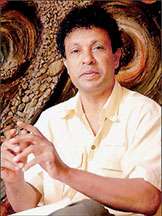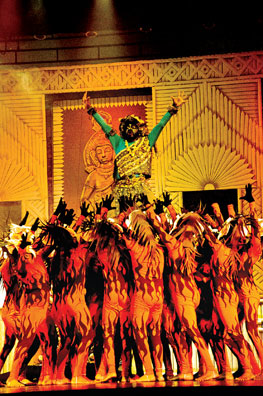Mahasamayama, drama of dramas
By Kalakeerthi Edwin Ariyadasa
|

Mahasamayama director
Prof. Ariyaratne Atugala
|
"Myths have four basic functions - The Mystical Function -
experiencing the awe of the universe; the Cosmological Function -
explaining the shape of the universe; the Sociological Function -
supporting and validating a certain social order; and the Pedagogical
Function - teaching how to live a human lifetime, under any
circumstance." - Joseph Campbell (1904-1987)
American Mythologist
Mahasamaya, overwhelmed the distinguished assemblage of aficionados
who, headed by President Mahinda Rajapaksa, thronged the massive space
of The Nelum Pokuna Mahinda Rajapaksa Theatre, to witness this
spectacular grand opera, at the invitation of the Presidential
Secretary, Lalith Weeratunga.
Its opening night, etched itself indelibly, in the depths of the mass
psyche, by its telling impact, as unparalleled entertainment and as a
never-to-be-forgotten audio-visual gala, that swept the spectators off
their feet (in a manner of speaking) sheerly through its Thespian magic.
Maestro
The maestro, who conjured up this dramatic wizardry, is
prestidigitator - director - Prof. Ariyarante Atugala. Assiduously
mining a sumptuous treasure - trove of myths, legends and folk-lore, to
bring into being a visual poem, a play (as the director himself
describes it) Prof. Ariyaratne Atugala presents to the country and of
course to the world at large an unprecedentedly spectacular musical
pageant.
|

A scene from the play |
When we consider the massive dramatic effort made by director Atugala
and his stupendous team that exceeds 250, it is essential to dwell at
least peripherally on role of myth, legend and folk-lore on the cultural
history of mankind.
Greek culture, that by common consent possesses the world's richest
endowments of myth, legend and folk-lore has gifted to mankind a whole
world of material to enliven creativity in drama, music and literature.
This store of myths and legends, has seeped down to the masses as a
folk-heritage, giving a satisfying depth to the lives, even of the
ordinary people. Sophocles (496-406 BC) dramatised the Oedipus myth.
The vast array of Greek myths has travelled down the corridors of
time to reach even our day. In his classic The Greek Myths, the British
mythologist Robert Graves, has recorded 171 main myths, which have
ramified into thousands of sub-streams.
Director Ariyaratne Atugala's myth nourishing creative quest should
be made the point of departure to make a substantial effort to record
scientifically and methodically, our own indigenous heritage of myths,
legends and folklore, before they are irretrievably eroded by modern
cynical disregard.
Heritage of myths
To my mind, after Greece, it is our own little island Sri Lanka, that
can be justly proud of an indigenous, fertile and fecund heritage of
myths, legends and folklore.
We can claim this prestigious stature, especially because Sri Lanka
has continued to nurture our lore of myths, legends and folk-ways,
through living rites and rituals. It may perhaps be that, Sri Lanka is
the only ancient culture that possesses a stunning range of masks and
dance forms, that perpetuate the myths and legends we have inherited, as
a living force.
Mahasamayama (The mega incarnation) has fabulously synthesised a
variegated array of choreographic formats, vocalisation variations,
stage - arrangement techniques, stage-docor systems and musical
orchestrations.
The curtain-raiser overture, pays a praiseworthy tribute to musical
values of both indigenous and in-coming tradition.
In a witty introduction to the musical pageant, pre-eminent
communicator Bandula Padmakumara, characterised the play as a bird's
eyeview of the world, eschewing the accustomed fish-eye view.
The chorus leader Nissanka Diddeniya resorting to his well-seasoned
booming, sonorous vocal entertainment, announced the play, in a costume
that echoed the Greco-Roman Toga.
Central myth
When the main dramatic banquet arrived we were convinced that, here
was a larger-than-life play production that fitted the enormous space
and the sophisticated techniques of the Nelum Pokuna Stage - hand in
glove.
The dramatic movements occurred sans even the slightest false step.
The director had taken care to see that Channa Wijewardene was on hand
(and on feet too as actor in the role of Ishwara) to meticulously
oversee the choreography.
The special-efforts department, left no stone unturned as it were, to
ensure, that the atmosphere, the backdrop all the adjuncts were
meticulously right.
Then came the central myth of the emergence of the dreaded Mahasona -
a name that instils fear into folk-minds even in this
super-sophisticated day and time.
Brahma-Sura, a love-rival to Ishvara proves a threat to the
three-eyed deity.
His friend God Vishnu disguised as a comely divine maiden, destroys
Brahma - Sura, in a stratagem, to which this romance-crazed Brahma Sura
falls victim. Incinerated into a glowing heap of ashes, Brahama Sura,
rises like the legendary bird phoenix, from his burning pyre.
Re-incarnated as Mahasona (to my mind that name implies "The Great
Hound) Brahmasura, still the unequallable illicit romantic, pounces upon
the comely wife of the mythical giant "Gotaimbara", to satiate his
carnal greed.
Gotaimbara challenges him to a duel, and with a single stroke of his
small-toe, serves Brahma Sura's head.
Well-meaning Saturn (Senasuru) searches in vain for Brahma-Sura's
lost head. Finding instead, the head of a ferocious bear, Brahma Sura is
given yet another incarnation as the repulsive embodiment of evil.
The director turned dramatist Gotaimbara into a divine hero, while
bear-headed Mahasona, looms large in the backdrop symbolising in all
that is repulsive.
The players, generally speaking, are super-duper. Channa Wijewardena
as Ishwara, comes to his own in terms of choreography.
Jackson Anthony as Mahasona portrays all that is threateningly
diabolical, while Sriyantha Mendis as "Gotaimbara" asserts himself as
the all-powerful hero, deploying his people to move massive trees with
the least effort. Actress Chaturika Pieris continued her star-charm.
Mega production
What comes in the aftermath of a mega production of this calibre?
That, to my mind, is the crucial issue.
Way back in 1956, Sarachchandra ushered in a far-flung revolution in
the stage-play by introducing his stylised Maname. Fortunately, it is
replicable, can be produced, even in a school, lacking advanced
facilities.
But, Mahasamayama is a totally different proposition. It is hugely
investment - intensive. Drilling the players is equally problem fraught.
As I see it, the State should produce this seasonally as a
substantial cultural gift to the people, at the theatre which has the
potentiality to be the theatrical haven of the masses. Director Prof.
Ariyaratna Atugala is a person of epic heroism. Perhaps he could bring
another Mahasona to Nelum Pokuna with yet another stunning spectacular
production of this unthinkable glamour. |



